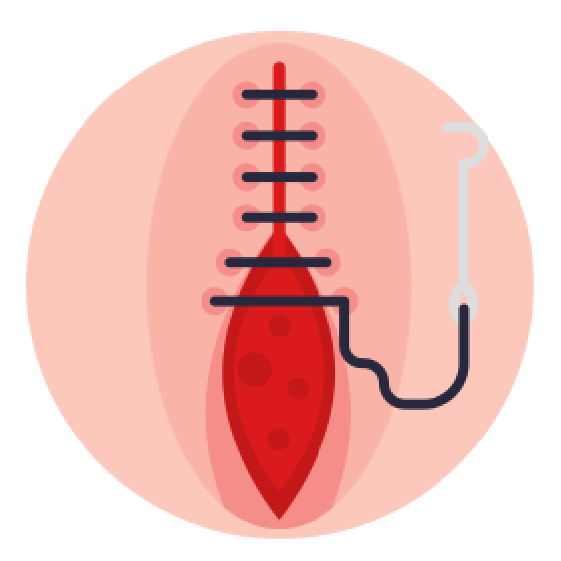Wound Care Clinic
Diabetes Ulcer Wound
A diabetic ulcer refers to an exposed wound where the skin has been partially or completely lost in an individual with diabetes. Typically, these ulcers manifest on the feet of people suffering from diabetes mellitus. They are commonly devoid of pain since individuals often experience reduced sensation in their feet.
Diabetic ulcers represent a significant and potentially life-changing complication linked to diabetes. It is imperative for individuals with diabetes to take proactive measures to avert these ulcers and to promptly seek medical attention if they encounter any foot problems to reduce the chances of complications. Consistent consultations with a healthcare provider or a diabetes specialist are vital for both diabetes management and the prevention of diabetic ulcers. But that does not necessarily mean that every diabetic patient will suffer from diabetic ulcer. Hence this can be prevented by doing regular foot examinations, wearing suitable footwear, and maintaining proper foot hygiene.
The Causes
What Sparks Diabetes Ulcer?
According to Very Well Health individuals with diabetes who have peripheral neuropathy (nerve damage, often in the limbs) and ischemia (reduced blood flow, typically due to peripheral arterial disease, PAD) are at higher risk of developing diabetic foot ulcers and other foot problems. The primary risk factor is the loss of protective sensation, where individuals cannot feel pain or temperature. Complex foot ulcers can lead to infection, the need for foot amputation, and, in severe cases, even death due to sepsis. These ulcers result from a combination of factors and do not appear spontaneously.
For instance, if someone with reduced sensation gets a blister or injury, they might not notice it, allowing it to progress into an ulcer. Peripheral neuropathy, a common nerve dysfunction in diabetes, often affects the feet, legs, and sometimes the arms and hands. Factors such as prolonged high blood sugar levels, smoking, and genetic predisposition increase the risk of neuropathy. Elevated blood sugar levels over time can damage nerves, leading to pain insensitivity and balance issues, increasing the risk of falls.
In cases where neuropathy causes foot injuries to go unnoticed, it can escalate to Charcot foot, which involves progressive damage to bones and joints, resulting in foot deformity. Autonomic neuropathy, another complication, reduces sweating, causing dry feet, which, in turn, raises the risk of calluses. While calluses are usually harmless, they can become problematic if sensation is lost, potentially leading to blisters or ulcers.
Peripheral arterial disease (PAD), occurring when arteries supplying blood to the legs and feet are blocked or partially obstructed, often coexists with neuropathy, increasing the likelihood of foot ulcers. Deformities like Charcot foot or hammertoe can also heighten the risk of skin breakdown, especially when combined with the loss of sensation.
Additional factors influencing ulcer risk include age, duration of diabetes, gender (with males at higher risk), ethnic background (more common among Latinx, Native American, or African-Caribbean individuals), previous ulceration, other microvascular complications (such as diabetic retinopathy and kidney disease), recipients of kidney, pancreas, or kidney-pancreas transplants, and the inappropriate use of creams for corns and calluses in individuals with neuropathy and diabetes.
Multidisciplinary Approach to Treat Diabetes Ulcer
A multidisciplinary approach is often used in the treatment of a diabetic ulcer, also known as a diabetic foot ulcer, and may comprise the following elements:

Wound Care

Pain Management

Infection Control

Vascular Assessment

Proper Footwear

Blood Sugar Control

Claim your free 20-minute doctor consultation online today!
Book Now ›

Tactics
Strategies For Diabetes Ulcer Relief
Wound Care: Treatment for the ulcer depends on factors like size, depth, infection, blood flow, and nutritional status. It varies over time and between healthcare providers
Debridement: Debridement involves removing dead or infected tissue to promote healing. Various techniques can be used for this purpose.
Infections: Early detection and treatment of infections are crucial to prevent complications. Signs of infection include warmth, redness, drainage, or an unpleasant odor. Diagnostic tests include wound cultures, blood samples, X-rays, and advanced imaging. Antibiotics are typically used to treat infections, but they don’t prevent recurrence.
Adjunctive Therapies: These additional treatments, used alongside standard wound care, can improve outcomes. Early adoption of adjunctive therapies may be beneficial.
Off-loading: Off-loading involves reducing pressure on the ulcer to facilitate healing. Devices like therapeutic shoes, custom insoles, and casts are used to protect the foot from further damage.
Foot-Care Education: Education on peripheral neuropathy, ulcer causes, warning signs, and preventive measures helps people detect and manage wounds.
Establishing Blood Circulation: Ensuring proper blood flow is essential for wound healing. Revascularization procedures may be needed, especially if the person has peripheral artery disease (PAD).
Nutritional Support and Blood Sugar Control: Managing blood sugar levels is crucial. Adequate control, along with increased protein intake, vitamin C, and zinc, can support healing. Consult a dietitian for personalized meal planning.
Call us
(+1) 123 456 78
The Trio of Diabetes Ulcers
Neuropathic, Neuroischaemic, and Ischaemic

There are three distinct categories of diabetic foot ulcers: neuropathic, neuroischaemic, and ischaemic. Sensory neuropathy is the primary cause of the majority of these ulcers, as patients often fail to perceive minor injuries, leading to untreated wounds due to the absence of pain symptoms unless they undergo routine assessments for early detection. Myocardial infarction is a significant event associated with peripheral arterial disease, increasing the risk of ischemia. However, ischemia contributing to diabetic ulcers introduces substantial morbidity and healthcare expenses, as it can become a chronic complication that proves challenging to manage due to inadequate blood supply.
Professional Support
Expert psychological consultation services

Chronic Wound
A wound, whether acute (caused by an injury) or chronic (persistent), goes through a typical healing process involving stages of hemostasis, inflammation, proliferation, and remodeling.

Diabetic Ulcers
Diabetic ulcers, most commonly found on the feet, are open sores or wounds. They occur primarily due to poor circulation, neuropathy (nerve damage), and increased pressure on certain foot areas.

Venous Ulcers
Venous ulcers, a complication of venous insufficiency, have a notable impact on an individual’s quality of life. As these wounds can be notoriously hard to heal, understanding their origin and treatment is essential.

Pressure Wounds
Pressure wounds are injuries to the skin and underlying tissue caused by prolonged pressure on specific areas of the body. Understanding their cause, prevention, and management is crucial for maintaining skin health.
Skilled Doctors
Our therapy specialists
Client Inquiries
Institution insights & answers to your questions
What problems might untreated diabetic ulcers cause?
Diabetic ulcers that are left untreated can result in significant side effects like cellulitis (a skin infection), abscesses, gangrene, and even amputation. Diabetes patients are more susceptible to infections spreading quickly.
What is the recovery time for a diabetic ulcer?
The size, depth, and success of therapy all affect how quickly an ulcer heals. Depending on the ulcer, healing might take a few weeks or many months.
If I have a diabetic ulcer, when should I see a doctor?
If you have any symptoms of infection (such as redness, warmth, or discharge), sluggish healing, or changes in the look of the ulcer, you must consult a doctor very once.
How should I proceed if I believe I have a diabetic ulcer?
You should seek quick medical assistance if you think you have a diabetic ulcer or observe any indications of a foot issue. Complications can be avoided with early treatment.
